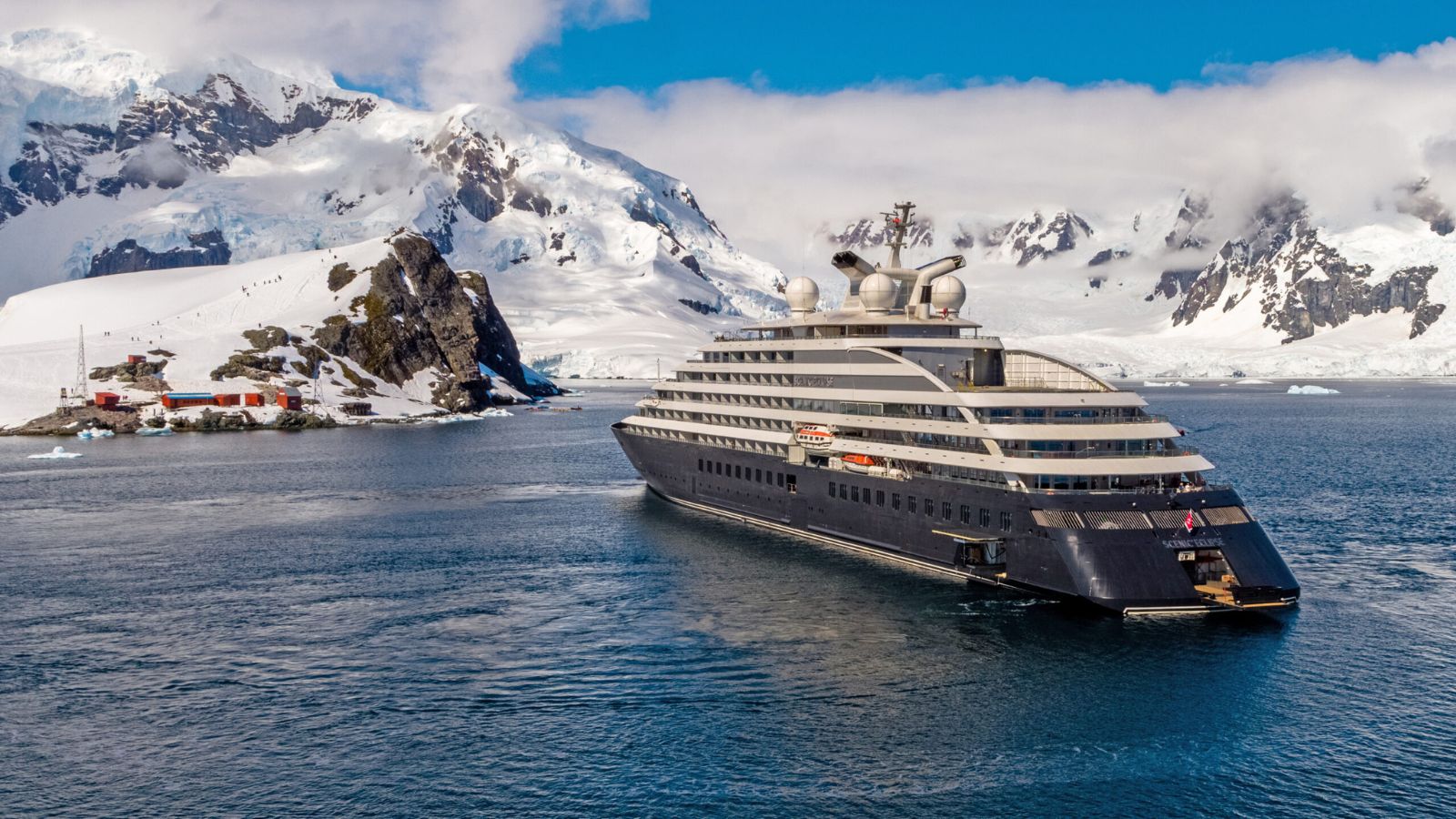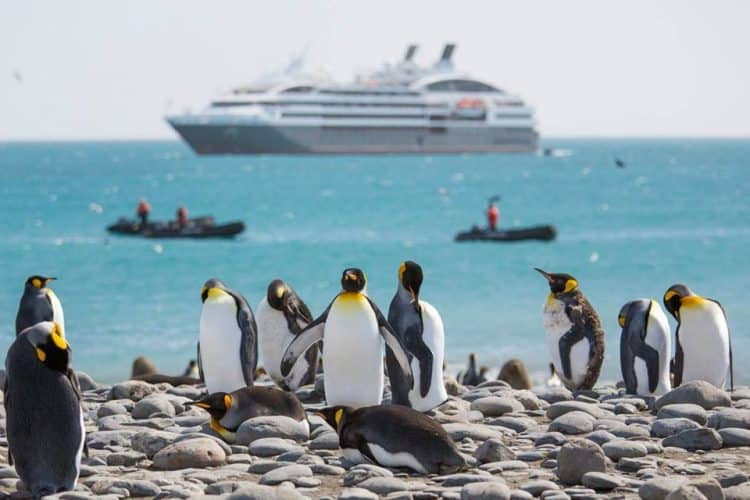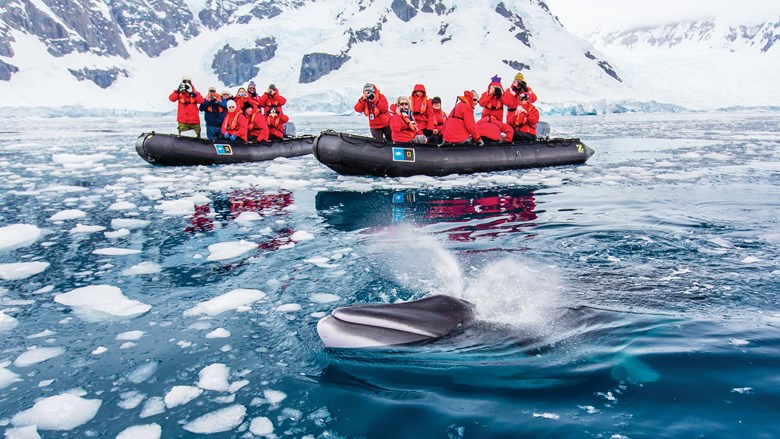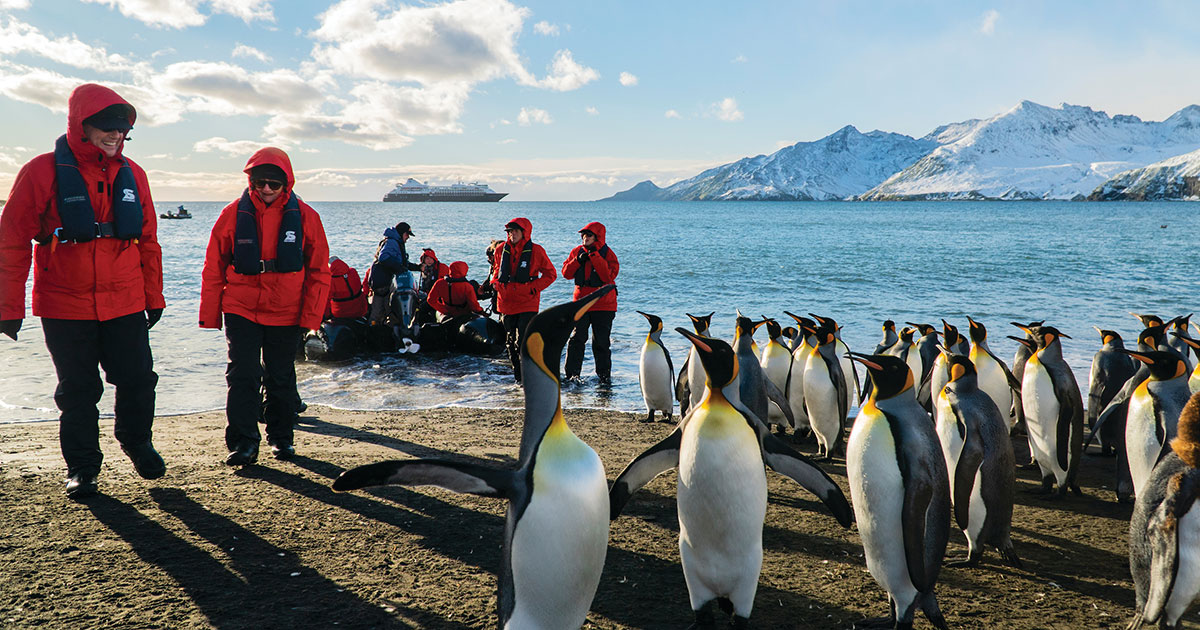Fuel spills and invasive species could be just the tip of the
iceberg when it comes to the impacts of increasing tourism in
Antarctica.
Photo: Scenic Luxury Cruises and Tours
From Sierra Club by Jen Rose Smith
Even after Captain James Cook first sailed below the Antarctic Circle 250 years ago, icily inhospitable Antarctica stayed quiet for a long, long time.
The only continent with no native human population, it remained a place apart, where occasional expeditions and intrepid researchers contended with harsh and sometimes-deadly conditions.
That’s changed with remarkable speed in recent years.
This austral summer, some 100,000 tourists are projected to arrive in Antarctica by cruise ship or long-haul flight, according to the International Association of Antarctica Tour Operators (IAATO).
That would top the previous record by 40 percent.
Real-time tracking by Cruise Mapper shows cruise ships clustered thick as snow fleas along the continent’s northern tip.
In 2021, an Airbus A340 operated by boutique aviation company Hi Fly landed on the continent for the first time, signaling the potential for even greater growth in the coming years.
Experts from Antarctic ecologists to marine scientists are sounding the alarm about the environmental impacts of that swelling human presence.
Average per-passenger CO2 emissions for an Antarctic vacation are 4.14 tons—which is just about the same amount of carbon pollution that the average human produces in an entire year.
Other factors affect Antarctica more directly: Each tourist arrival accounts for an average of 83 tons of snow loss,a 2022 paper found, since the black soot that cruise ships emit hastens melting by absorbing sunlight.
Antarctic ecologists point to looming risks of fuel spills and seeds from non-native species hitchhiking on tourist clothing.
Invasive species are particularly urgent because most tourism is concentrated in ice-free coastal areas that have the continent’s greatest terrestrial biodiversity.
Non-native plants will only become more tenacious there as the climate warms.
Antarctic ecologist Dana Bergstrom, a principal research scientist at the Australian Antarctic Division, has studied the risk of visitors introducing invasive plants by turning a vacuum on their pants pockets and wooly sweaters.
“Some time ago I led an international program called Island of Antarctica, where we vacuumed tourists and national program people,” said Bergstrom.
“We picked up, in our vacuumings, all the major weed species in North America and Europe.” The lawn species common bluegrass (Poa annua), whose seeds can stay viable for four years, now has an established foothold in Antarctica.
Sterilization and cleaning protocols can limit the potential impacts of such invasive species, and IAATO has worked with researchers to develop guidelines for its members.
But many observers would also like to see limits to the geographical area tourists can visit, or caps on visitation.
“Some of the greatest concerns are about the cumulative impacts.
Not just the impact of tourists landing in one place, one day, but effects that many landings, over many weeks and months might have on that place,” says Ricardo Roura, a senior adviser for the Antarctic and Southern Ocean Coalition, which represents environmental NGOs from 40 countries.
“Some time ago I led an international program called Island of Antarctica, where we vacuumed tourists and national program people,” said Bergstrom.
“We picked up, in our vacuumings, all the major weed species in North America and Europe.” The lawn species common bluegrass (Poa annua), whose seeds can stay viable for four years, now has an established foothold in Antarctica.
Sterilization and cleaning protocols can limit the potential impacts of such invasive species, and IAATO has worked with researchers to develop guidelines for its members.
But many observers would also like to see limits to the geographical area tourists can visit, or caps on visitation.
“Some of the greatest concerns are about the cumulative impacts.
Not just the impact of tourists landing in one place, one day, but effects that many landings, over many weeks and months might have on that place,” says Ricardo Roura, a senior adviser for the Antarctic and Southern Ocean Coalition, which represents environmental NGOs from 40 countries.
Managing impacts of Antarctic tourism, however, is complicated.
No national government controls Antarctica, so governance is guided by the 55-party Antarctic Treaty that became active in 1961.
Making rules in Antarctica is more like dealing with all the outer space junk orbiting Earth than it is like regulating tourism in Barcelona, Spain, or Easter Island.
“We have a lot of different entities with geopolitical interests, and they’re all working together to manage this huge part of the globe, and that makes it harder for one voice to take charge,” says Peter Carey, a global fellow at the Polar Institute of the Wilson Center.
“You have to get all 55 parties to say, Yes, that’s the way we want to do it.
That’s the biggest challenge.”
The treaty members have started to consider Antarctic tourism’s environmental impacts.
Last year, they passed a nonbinding resolution banning the construction of permanent facilities for tourism and other nongovernmental activities in Antarctica, in hopes of limiting inland visitation.
(This won’t touch the growing number of technically nonpermanent tourist tent camps, some of which have been in place for decades.) They’ve also stopped short of policies that would limit the overall scale of tourism.
The number of tourist arrivals in Antarctica remains a simple factor of wealth—an Antarctic cruise can easily run US $10,000—and inclination.
“Antarctic tourism is essentially market driven,” Carey says.
“If you can afford to go, you can go. The demand is being met. Left unregulated, I think that will continue to be the case—the number of people in Antarctica will be determined by who wants to go and not who can go [from a sustainability perspective].”
Much of this is true of tourism in general, since long-distance travel is a luxury available to anyone with enough cash and passport privilege.
While a few popular destinations like Venice, Italy, and Amsterdam, Netherlands, are seeking to limit tourist numbers, such examples are exceptions to a global norm.
Many see Antarctica as simply different, however, a piece of natural heritage worthy of special protections.
“For future generations I think it would be good to keep it as an intact system as much as possible,” says Bergstrom, the ecologist.
So should we stay away from Antarctica altogether? There is something appalling about “last chance tourism,” a carbon-intensive rush led by elite citizens of rich countries—already the world’s top per-capita emitters—who wish to see the places most vulnerable to climate change.
“That has people producing very high emissions to see something that’s affected by those high emissions,” says researcher Eke Eijgelaar at the Netherlands’ Breda University of Applied Sciences, who outlined the issue in a 2010 paper in the Journal of Sustainable Tourism.
While IAATO argues that many travelers will return home from Antarctica as ambassadors for the region who are newly empowered to educate and create positive change, Eijgelaar rejects the theory of ambassadorship.
His research found that visiting the Antarctic had no meaningful impact on tourists’ environmental awareness.
Most of the tourists he surveyed said the experience didn’t change their views on climate change at all, while 14 percent returned home reassured that the climate crisis wasn’t as bad as they previously thought.
Still, tallying tons of carbon doesn’t account for the value of encountering beauty in an awe-inspiring place, or of glimpsing something truly wild.
Such intangibles are the daily arithmetic of life in a warming world.
While Antarctic travel has an outsize footprint, the difference is one of scale, not kind.
All journeys have an environmental impact: each of us, not just Antarctic tourists, must answer the question of how to balance joy, wonder, and environmental responsibility.
And while Eijgelaar found no real change in his surveys, other research has found that connections to nature can result in pro-environmental behavior.
For many in the environmental movement—including Sierra Club founder John Muir—experiences in the outdoors have inspired greater urgency about the need for systemic change.
“I think it really gives you a sense of the vast, amazing wilderness that we have,” says Kath Giel, a trip leader for the Sierra Club’s expedition cruises to Antarctica, of her own encounters with the white continent.
“This incredible place of beauty and nature needs to be protected.” When leading Sierra Club trips to Antarctica in collaboration with the company Oceanwide Expeditions, she invites travelers to attend lectures on climate change, the natural world, and the polar environment.
Giel hopes that such journeys will forge a personal connection that will translate to real-world advocacy.
“If you ever question the value of a vast, untouched wilderness, then you should go to Antarctica to see it,” Giel says.
“You’re going to be more likely to want to protect that place than if it’s something you don’t really know.”
Links :




No comments:
Post a Comment